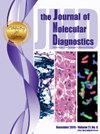Repurposing the Whole Expression Transcriptome Assay for the Genetic Diagnosis of T-Cell Acute Lymphoblastic Leukemia and Lymphoma
IF 3.4
3区 医学
Q1 PATHOLOGY
引用次数: 0
Abstract
Unlike other cases of acute leukemia, the diagnosis of T-cell acute lymphoblastic leukemia/lymphoma (T-ALL/LBL) is uniquely based on morphology and flow cytometry. Although the genomic background has been broadly uncovered, the large spectrum of genes involved and the variability of the molecular mechanisms underlying gene deregulation have delayed the introduction of molecular cytogenetics into diagnostic flowcharts. To overcome these limitations and implement a genetic diagnosis of T-ALL/LBLs, a whole transcriptome expression assay (WTEa) was repurposed as a “priority test” to classify T-ALL/LBLs into the major genetic subtypes. A WTEa classifier based on a set of 312 probes on 215 T-ALL/LBLs was set up and applied, which properly assigned >95% of cases with subtype-defining alterations to the corresponding subgroups (ie, TAL/LMO, HOXA, TLX1, TLX3, BCL11B). It pinpointed cases that harbored cryptic alterations, such as noncoding mutations that generate new enhancer at TAL1 and LMO2 loci (8% of TAL/LMO), and duplications of noncoding element downstream BCL11B (BETA) (18% of BCL11B). It was also suitable to classify lymphoma cases for which only formalin-fixed embedded tissues were available, as confirmed in cases harboring TLX1 or TLX3 rearrangements, and distinguished new putative subtypes. WTEa offers a unifying tool to provide a genetic classification of T-ALL/LBLs. If introduced in multicenter prospective studies, it will facilitate evaluation of the clinical impact of genetic classification.

全表达转录组测定在t细胞急性淋巴细胞白血病和淋巴瘤的遗传诊断中的应用。
与其他急性白血病不同,t细胞急性淋巴细胞白血病/淋巴瘤(T-ALL/LBL)的诊断是基于形态学和流式细胞术的独特诊断。尽管基因组背景已被广泛揭示,但涉及的基因谱和基因解除管制的分子机制的可变性推迟了将分子细胞遗传学引入诊断流程图。为了克服这些限制并实现T-ALL/LBLs的遗传诊断,我们重新利用全转录组表达测定(WTEa)作为“优先测试”,将T-ALL/LBLs分类为主要遗传亚型。我们基于215个T-ALL/LBLs的312个探针建立并应用了一个WTEa分类器,该分类器将95%的具有亚型定义改变的病例正确地分配到相应的亚组,即TAL/LMO、HOXA、TLX1、TLX3和BCL11B。其中,它确定了隐藏改变的病例,例如在TAL1和LMO2位点产生新的增强子的非编码突变(占TAL/LMO的8%),以及BCL11B下游非编码元件(BETA)的重复(占BCL11B的18%)。对于只有福尔马林固定包埋组织的淋巴瘤病例,如在TLX1或TLX3重排病例中证实的,也适用于分类,并区分新的推定亚型。WTEa提供了一个统一的工具来提供T-ALL/LBLs的遗传分类。如果在多中心前瞻性研究中引入,将有助于评估遗传分类的临床影响。
本文章由计算机程序翻译,如有差异,请以英文原文为准。
求助全文
约1分钟内获得全文
求助全文
来源期刊
CiteScore
8.10
自引率
2.40%
发文量
143
审稿时长
43 days
期刊介绍:
The Journal of Molecular Diagnostics, the official publication of the Association for Molecular Pathology (AMP), co-owned by the American Society for Investigative Pathology (ASIP), seeks to publish high quality original papers on scientific advances in the translation and validation of molecular discoveries in medicine into the clinical diagnostic setting, and the description and application of technological advances in the field of molecular diagnostic medicine. The editors welcome for review articles that contain: novel discoveries or clinicopathologic correlations including studies in oncology, infectious diseases, inherited diseases, predisposition to disease, clinical informatics, or the description of polymorphisms linked to disease states or normal variations; the application of diagnostic methodologies in clinical trials; or the development of new or improved molecular methods which may be applied to diagnosis or monitoring of disease or disease predisposition.

 求助内容:
求助内容: 应助结果提醒方式:
应助结果提醒方式:


